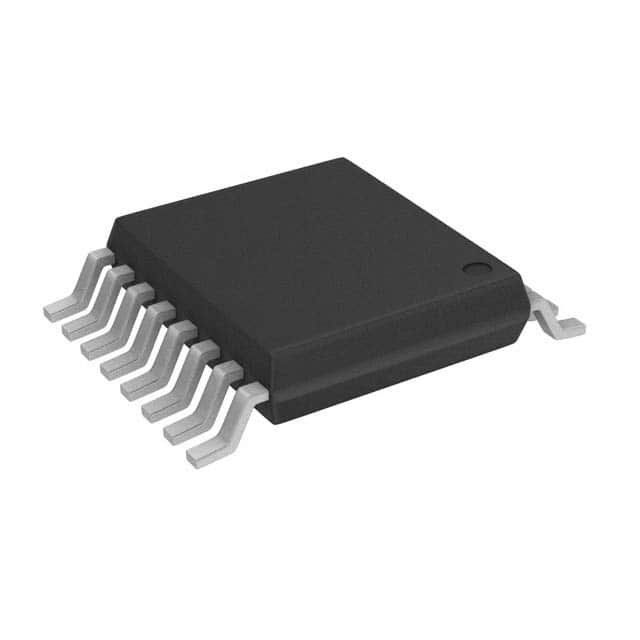Lihat spesifikasi untuk detail produk.

NX3L4051PW-Q100J
Product Overview
- Category: Analog Switch
- Use: The NX3L4051PW-Q100J is a high-performance analog switch designed for use in various applications such as audio and video signal routing, data acquisition systems, and communication devices.
- Characteristics: This analog switch offers low ON-resistance, low leakage current, and wide voltage range operation, making it suitable for both battery-powered and industrial applications.
- Package: The NX3L4051PW-Q100J comes in a small footprint TSSOP-16 package, which provides space-saving benefits and ease of integration into compact designs.
- Essence: The essence of this product lies in its ability to provide reliable and efficient signal routing capabilities while maintaining low power consumption and high performance.
- Packaging/Quantity: The NX3L4051PW-Q100J is typically packaged in reels of 2500 units.
Specifications
- Number of Channels: 8
- ON-Resistance: 4 Ω (typical)
- Leakage Current: 1 nA (typical)
- Operating Voltage Range: 1.65 V to 5.5 V
- Bandwidth: Up to 200 MHz
- Power Supply Current: 0.5 μA (typical)
- Operating Temperature Range: -40°C to +125°C
Detailed Pin Configuration
The NX3L4051PW-Q100J features a TSSOP-16 package with the following pin configuration:
┌───┬───┬───┬───┐
│ 1 │ 2 │ 3 │ 4 │
├───┼───┼───┼───┤
│ 5 │ 6 │ 7 │ 8 │
├───┼───┼───┼───┤
│ 9 │10 │11 │12 │
├───┼───┼───┼───┤
│13 │14 │15 │16 │
└───┴───┴───┴───┘
Functional Features
- Low ON-Resistance: The NX3L4051PW-Q100J offers a low ON-resistance, minimizing signal attenuation and ensuring high-quality signal routing.
- Wide Voltage Range Operation: This analog switch can operate within a wide voltage range, making it compatible with various power supply configurations.
- Low Leakage Current: With a low leakage current, the NX3L4051PW-Q100J minimizes power consumption and ensures accurate signal routing.
- Fast Switching Speed: The switch provides fast switching speeds, enabling seamless signal routing in time-critical applications.
Advantages and Disadvantages
Advantages: - Low ON-resistance for minimal signal attenuation - Wide voltage range operation for compatibility with different power supplies - Low leakage current for reduced power consumption - Fast switching speed for time-critical applications
Disadvantages: - Limited number of channels (8)
Working Principles
The NX3L4051PW-Q100J operates based on the principle of field-effect transistors (FETs). It utilizes MOSFET technology to control the flow of signals between its input and output channels. When a control signal is applied, the corresponding FET switches ON, allowing the signal to pass through. By selectively activating the appropriate FETs, the desired signal routing can be achieved.
Detailed Application Field Plans
The NX3L4051PW-Q100J finds applications in various fields, including:
- Audio and Video Signal Routing: The analog switch can be used to route audio and video signals in multimedia devices, such as televisions, set-top boxes, and gaming consoles.
- Data Acquisition Systems: It is suitable for use in data acquisition systems where multiple sensors or signal sources need to be connected to a single data acquisition unit.
- Communication Devices: The switch can be employed in communication devices, such as routers and switches, to facilitate signal routing between different ports.
Detailed and Complete Alternative Models
- NX3L4051PW-R
- NX3L4051PW-Q100H
- NX3L4051PW-Q100JX
These alternative models offer similar functionality and characteristics to the NX3L4051PW-Q100J and can be considered as alternatives based on specific requirements and availability.
Word count: 520 words
Sebutkan 10 pertanyaan dan jawaban umum terkait penerapan NX3L4051PW-Q100J dalam solusi teknis
Sure! Here are 10 common questions and answers related to the application of NX3L4051PW-Q100J in technical solutions:
Q1: What is the NX3L4051PW-Q100J? A1: The NX3L4051PW-Q100J is a high-performance analog multiplexer/demultiplexer IC (Integrated Circuit) that allows multiple analog signals to be routed to a single output or vice versa.
Q2: What is the purpose of using the NX3L4051PW-Q100J in a technical solution? A2: The NX3L4051PW-Q100J is commonly used in applications where there is a need to switch or route multiple analog signals, such as in audio/video systems, data acquisition systems, and test equipment.
Q3: How many channels does the NX3L4051PW-Q100J have? A3: The NX3L4051PW-Q100J has 8 channels, which means it can handle up to 8 different analog signals.
Q4: What is the voltage range supported by the NX3L4051PW-Q100J? A4: The NX3L4051PW-Q100J supports a wide voltage range from -0.5V to +6V, making it suitable for various analog signal levels.
Q5: Can the NX3L4051PW-Q100J handle both analog and digital signals? A5: Yes, the NX3L4051PW-Q100J can handle both analog and digital signals, making it versatile for different types of applications.
Q6: How is the NX3L4051PW-Q100J controlled? A6: The NX3L4051PW-Q100J is controlled through digital inputs, typically using logic signals to select the desired channel or configuration.
Q7: What is the maximum current handling capability of the NX3L4051PW-Q100J? A7: The NX3L4051PW-Q100J can handle a maximum continuous current of 200mA, making it suitable for most low-power analog applications.
Q8: Can the NX3L4051PW-Q100J be used in both bidirectional and unidirectional applications? A8: Yes, the NX3L4051PW-Q100J can be used in both bidirectional and unidirectional applications, depending on the specific configuration and requirements.
Q9: Does the NX3L4051PW-Q100J require external power supply or voltage reference? A9: Yes, the NX3L4051PW-Q100J requires an external power supply to operate. It typically operates from a single positive power supply voltage.
Q10: Is the NX3L4051PW-Q100J available in different package options? A10: Yes, the NX3L4051PW-Q100J is available in various package options, including TSSOP (Thin Shrink Small Outline Package) and HVQFN (Very Thin Quad Flat No-Lead) packages, providing flexibility for different PCB layouts and space constraints.
Please note that these answers are general and may vary depending on the specific application and requirements.

